Middelburg to Bruges
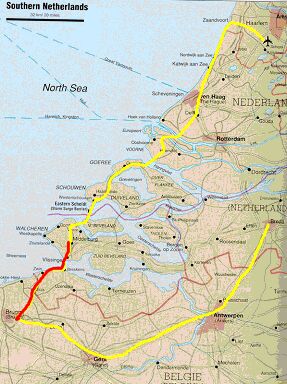
Middelburg to Bruges

Middelburg to Bruges (in Red)
After breakfast I stood underneath the awning outside my hotel watching the
pouring rain. The street was filled with biking commuters heading to the train
station across the street. I was impressed. I had to go out in this downpour
myself, but this was a special trip for me, whereas for them this was simply
a regular commute. Many carried briefcases and wore business suits under their
raincoats. Also, I never could get used to seeing their biking posture, sitting
so high and erect in the seat. I’ve heard the typical bike in Holland
described as a “sit up and beg” design. This was so different from
the underslung handlebar design of my own bike. I kept thinking: if I lived
here would I be riding one of these bikes the way they do?
On the sidewalk under the awning I was surrounded by a group of bikers at the opposite extreme. This was a cross-generational tour of grandparents and children from California. Their den-mother leader explained to me what a wonderful thing it was to mix the generations. This was the first day of their tour, and they planned a seven-mile trip with the wind at their back. Sissies, I thought! From the expressions on some of the kid’s faces, maybe they agreed with me. I did think, though, that it was tough luck that they had to begin in this downpour.
I had planned this to be the easiest biking day of the trip. There was a short 4-mile run south along a canal to the town of Vlissingen, where a ferry would take me across the water towards Belgium. Then I would head straight down to Bruges, perhaps another 25 miles from the ferry port. At least it looked straight on the map. It never actually worked out that way though, and today was no exception. Still, it was an easy day as these things go.
The canal-side trip to Vlissingen went quickly and easily. The rain continued to pour, but something mysterious happened to the wind. It either wasn’t there, I was shielded, or it had turned to my back. Before I could decide which, I arrived at the ferry station in Vlissingen, where I bought a ticket to Brecken for about one dollar. It seemed that ferries here were marvelously cheap. And they seem really convenient, I thought, as the ferry pulled in just as I walked up.
I tied my bike to a railing in the hold alongside a number of trucks and climbed three flights of steep steps to the lounge, where I bought some coffee and settled in a window seat to view the murky waters outside. There wasn’t much to see, actually, but I kept looking. It was wonderful just to sit there in the dry and warmth and yet still be getting nearer to my destination. I didn’t think of the ferry as cheating, either. I mean, if I had taken a train or cab to shorten my journey that would have been cheating. With the ferry there was no choice.
As I studied my map for the route ahead I had a quick moment of panic. On the map I saw that two ferry routes originated at Vlissingen. One went directly across the water to Brecken, but the other went westward to England. I wasn’t on the wrong one, was I? I had visions of coming out in England. What an embarrassment that would be! But no, I thought rationally, there was no way that you could go to England for just one dollar. This had to be the one to Brecken. Take your time, I told the ferry. I’m in no hurry.
About twenty minutes went by very quickly, and the ferry docked on the other side. Damn, they were going to kick me off! I would have to go back into the downpour. Maybe I could just ride back and forth a couple of times. Sometimes after a pleasant break getting back in the saddle was an ordeal.
At the end of the gangplank I expected to see the highway from the map, heading straight south to Bruges, and harboring a nice fietspad. Instead, the highway looked unbikeable, and there was a familiar sign for the LF1 bike path that pointed to my right, westward. I wanted to go south, but I knew that LF1 went through Bruges, so it must know what it’s doing. So I followed the bike path, which shortly turned into little country roads with straight segments of about a half mile, followed by abrupt 45 degree turns – the kind of roads that seem to be laid out along property lines.
The going was tough. The wind that seemed to have disappeared on the other shore now seemed ferocious. I concentrated on just the next turn, and then the next, but there seemed to be no respite from that wind. I had forgotten the rain; the wind was my real enemy.
After about three miles of this torture, the path turned into a dirt path traveling west in the lee of a dike. The sea was on the other side of the dike, and every now and then there would be steps up the dike leading to a beach. I was tempted to climb up and see what was there, but I just kept pedaling through the rain. This was not so bad at all here. The only problem was that I was going sideways to my destination. My GPS told me that I had actually increased the distance to Bruges. I wasn’t getting anywhere, but it was relatively pleasant going.
After about four miles of this diversion, I reconsidered. This was a mental turning point in the trip where I grew a little disenchanted with the long distance bike paths. It seemed that they took a scenic route, and that if I actually wanted to get somewhere I should be taking a highway. Except for the freeways, all the highways seemed to have accompanying bike paths. There was even an advantage of the highways; they went through interesting little towns. On the other hand the long distance bike paths took you through solitary splendor – woods, meadows, windmills, and farm animals. You had your choice. This time I decided on a highway.
After a total of 20 miles of biking I reached the town of Sluis, which was the last town before entering Belgium. I had missed my morning break, and although it was a little early for lunch, this had to be a stopping point. Sluis had the air of a resort, and seemed curiously different from other towns. The main street was lined with restaurants, and I pondered the choice, eventually deciding on a Swiss restaurant. However, when I settled in a booth and looked at the menu I saw that all the dishes were very expensive. The cost didn’t bother me so much as the formality. I just wanted a sandwich, and there wasn’t anything like that on the menu. I got up to leave, and the waiter asked if I hadn’t found what I wanted. I said no, and he suggested that I could find a snack place on the side street.
I was surprised that all the restaurants I saw seemed equally expensive and formal as this first one. Was this a town of rich gourmets? I couldn’t find the snack place the waiter suggested, but eventually I settled at the inexpensive café on the right in this picture.
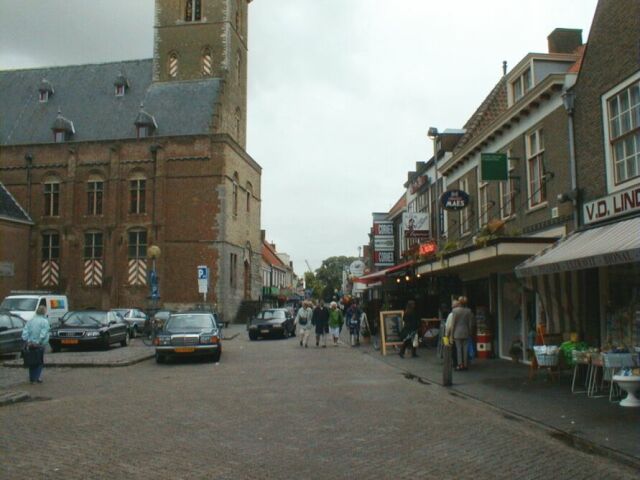
Sluis
At the entrance to the café I saw the two Germans that I had encountered on the Delta bridge the day before. I waved to them, but they looked at me in puzzlement. “Hamburg,” I said. Then they smiled in recognition. I would have liked to have asked them about how they camped out in the rain the previous night, but the language barrier put me off. The one who spoke a little English said that there was no food for him in this café, and they were in search of another one. Off they went.
I looked behind the counter at the unfamiliar foods displayed there. Maybe there wasn’t any food for me either. I saw one of those sausage-things similar to what I had had at the snack bar the day before, so I ordered that, along with chicken soup and a coke. This time, however, the sausage-thing wasn’t so good. They served it plain and it was rather tasteless. It needed the onions, mayonnaise, and curry I had been given previously.
Leaving Sluis I followed an arbitrary canal. It was going south, and there was a bike path, so why not? The wind was now to my side, and the canal was beautifully lined with tall trees.
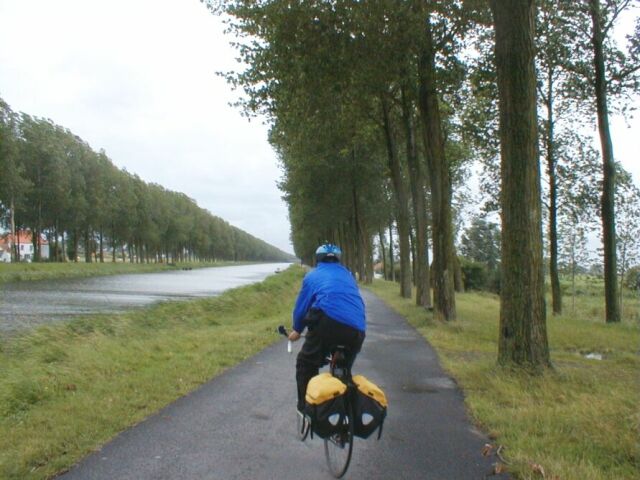
The Canal from Sluis
Somewhere along here I crossed the border into Belgium. In these days of the European Union, there seems rarely any formality, but I wondered what they used to do about bike paths. Did they have their own customs booths? I’ll probably never know.
From here to Bruges was the prettiest part of my trip. Even in the rain, which was now intermittent, this was idyllic. In the sunshine it must be exquisite. Here are some scenes along the canal.
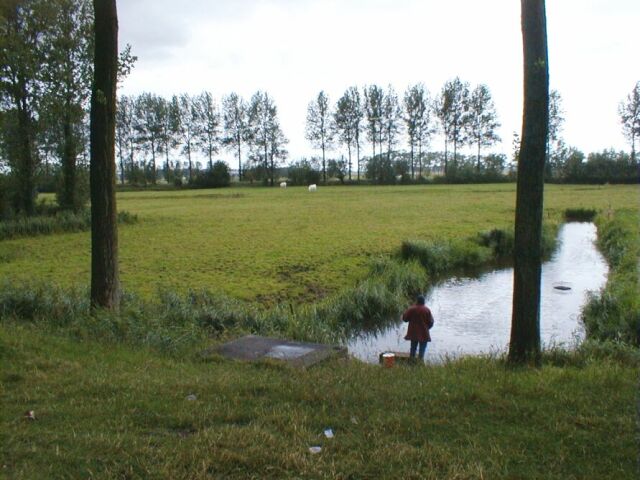
A solitary fisherman along the canal
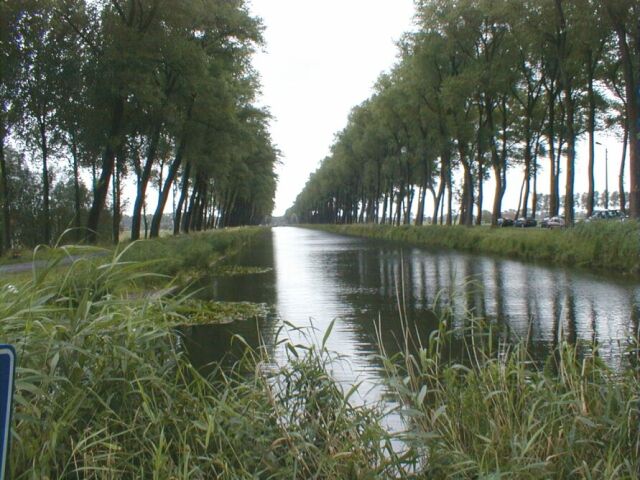
Scenes along the canal to Bruges
About four miles up the canal from Bruges was the touristy small city of Damme. A lot of tours from Bruges go there, and so do quite a number of day-bikers. I stopped there for an afternoon tea break. Maybe it was my imagination, but I sensed an immediate difference in the architecture of the buildings here. Many had a triangular roof design with stair-cased sides as you see in the picture below. I was to see this everywhere I went in northern Belgium. I had thought, too, that I would suddenly see French, which I could at least read. But no, everything was still in Dutch. People spoke Dutch, and all the signs were in Dutch. This was, after all, Flanders.
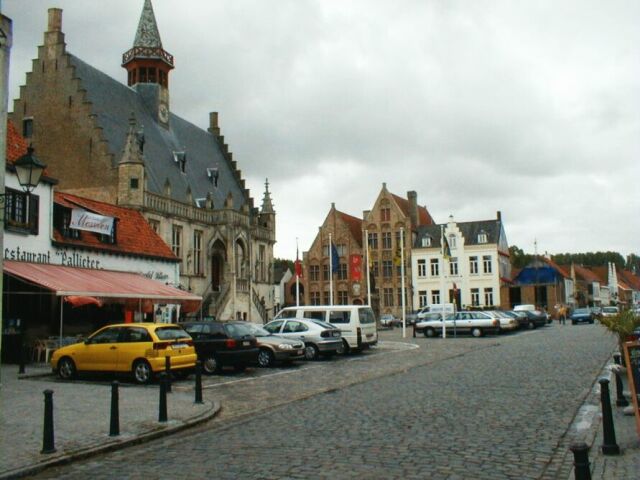
Damme
All the Dutch and no border crossing gave me the sense that my Netherlands money was still good. Not so, said the waitress at the patisserie. So I had to go in search of an ATM before I could fulfill my dream of a Belgium pastry. Returning, I eyed a particularly disgusting-looking meringue tart behind the counter. Could I buy just a piece, I asked? Indeed I could, and I got a cappuccino to go with it. Unfortunately, the truth is – it wasn’t very good!
The last miles to Bruges along the canal were especially beautiful. Not so, however, for the outskirts of Bruges. I was immediately cognizant of the fact that this was a sizeable city. I tried to follow the occasional signs to “Centrum” and “VVV”, but the signs were sporadic and the traffic was dense. I did see a pretty canal with a flotilla of swans, or whatever a bunch of swans is called. I later read that swans are special in Bruges, as symbols of the long neck from an historic beheading there. “May the swans always be in Bruges,” someone famous said. Something like that.
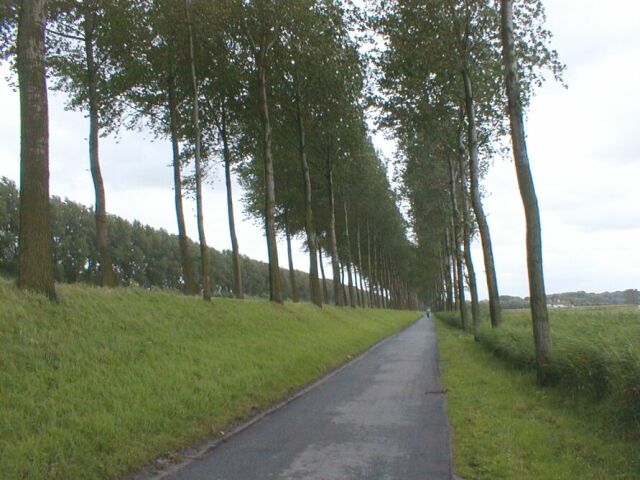
The last miles to Bruges
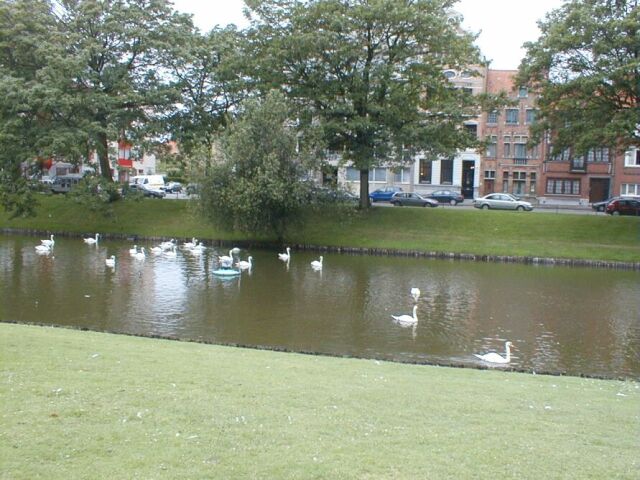
The swans at Bruges
I reached a very large, but plain, square. I later figured that it covered an underground bus terminal. People would disappear into the bowels of the plaza through little kiosks. On the surface was a statue of a biker. I read in a cycling book that every biker needed to have his picture taken in front of this statue. However, on this day I walked right past the statue without noticing it.
As I was pushing my bike across the square, an old lady pointed at me. “Tour de France,” she shouted. Hardly, I thought. I was surely bedraggled, and my packhorse bike and rain outfit were so unlike the sleek riders in that race. I wasn’t sure if she was being facetious or what. I hurried on.
I pushed my bike through the rain in a series of walking streets. I had understood that Bruges was a heaven for bikers, and indeed there were biking lanes everywhere. But the traffic was furious, and pedestrians were thronging everywhere. I was content to walk, but even that was difficult on the crowded streets.
Finally I reached the two main squares of Bruges, both surrounded by beautiful medieval buildings. My hotel, the de Swaene (another swan), was located on a canal behind the second square. It was a luxurious small hotel, and I sunk into a hot bath. There was even a hair dryer, and I turned it on my sneakers – the only part of my outfit that got lastingly wet.
I got a dinner suggestion from a guidebook, but when I went there it was closed. For some minutes I toured the brasseries around the big square. All had large outdoor seating areas and posted menus. However, they seemed so touristy and ordinary that I resisted. As I finished reading one of these menus and turned to leave, a waiter accosted me, “Our restaurant not good enough for you?” he taunted. Forget that one!
Finally I ate at a nondescript hotel-restaurant nearby. The dinner was forgettable, but seated on either side of me were two older ladies. One read a book all through her dinner, but turned to me to ask some question before leaving. She was very fat, and it turned out she was a professor of aeronautical engineering at a college in Florida. I was trying to think of academics that I knew in that field, and I mentioned Sheila Widnal. That was, I confess, terrible name-dropping. I’m ashamed of myself. She sort of blanched, and said, well of course she knew of her, but had never met her. Sheila is a professor at MIT who had just left the position of Secretary of the Air Force in the Clinton administration.
Meanwhile, the other lady joined in on the conversation. She said she would like to talk, but she was suffering from a terrible abscess in a tooth. Both women were in Bruges for vacations by themselves. I give them credit for their adventuring.
I awoke in the middle of the night and looked out of my hotel window. This is what I saw.

Bruges at night from my hotel window